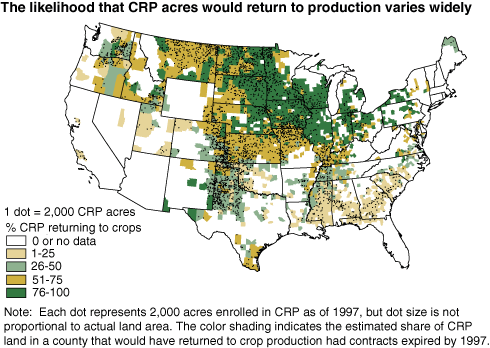Land Retirement Programs May Induce Enduring Land-Use Changes
- by Ruben N. Lubowski and Michael J. Roberts
- 2/1/2008
Agricultural policies aimed at improving the environment often rely on the voluntary participation of farmers. Rather than buying land or purchasing conservation easements that impose a permanent land-use restriction, the government typically “rents” environmental benefits from farmers by offering payments for temporary changes in land use or management. Longer term impacts from such programs are uncertain since farmers may choose to adopt less environmentally friendly land use or management practices once their payments cease. In practice, experience with the Conservation Reserve Program (CRP) indicates environmental benefits from the program often continue after payments stop.
The CRP offers annual rental payments to farm owners or operators who voluntarily stop crop production on eligible land under 10- to 15-year contracts and instead plant environmentally beneficial grass or tree covers. The CRP pays about $1.8 billion per year to retire almost 37 million acres (an area larger than Iowa). Benefits from the program, including increased recreation (see, Agritourism Offers Opportunities for Farm Operators), enhanced wildlife habitat, soil conservation, and other environmental services, have been valued in excess of these costs.
ERS analyzed trends in land use in the contiguous 48 States during periods before and after the first CRP contracts expired between 1995 and 1997. Findings indicate that approximately 38 percent of the land that exited CRP between 1995 and 1997 was not converted back to crop production in 1997. Exiting CRP lands not returned to crop production tended to remain in pasture, range, or forests—uses with land covers and environmental benefits similar to those contracted under CRP.
County-level predictions show wide regional variation in the likelihood that parcels would return to crop production after exiting CRP. Influential factors include the profitability of crop production and other land uses in a local area, the quality of the soil for crop production, and the land cover adopted under CRP. For example, land parcels that had established trees and wildlife covers under CRP were less likely to return to crop production than land covered with native grasses or legumes. Given the high current market prices for corn and other commodities, a higher proportion of land exiting CRP today may go back into crop production. Nonetheless, the rate of cropland conversions of land exiting CRP today would likely show the same geographic pattern displayed in the 1997 data.
This article is drawn from:
- Bucholtz, S., Sullivan, P., Hellerstein, D., Hansen, L., Johansson, R., Koenig, S., Lubowski, R.N., McBride, W.D., McGranahan, D., Vogel, S. & Roberts, M. (2004). The Conservation Reserve Program: Economic Implications for Rural America. U.S. Department of Agriculture, Economic Research Service. AER-834.
- Enduring Impacts of Land Retirement Policies: Evidence from the Conservation Reserve Program. (2007). Economic Research Service. in Land Economics, 83(4). .


